Transcriptome Analysis Reveals the Induction of Apoptosis-Related Genes by a Monoclonal Antibody against a New Epitope of CD99 on T-Acute Lymphoblastic Leukemia
Abstract
1. Introduction
2. Materials and Methods
2.1. Cells, Cell Lines and Antibodies
2.2. Cell Apoptosis Assay
2.3. RNA Extraction
2.4. mRNA Library Constructing and Sequencing
2.5. RNA-Sequencing Data Analysis
2.6. Real-Time Quantitative RT-PCR
- FOS—Fw: 5′-CTTACTACCACTCACCCGCA-3′
- FOS—Rv: 5′-AGTGACCGTGGGAATGAAGT-3′
- TNF—Fw: 5′-TGCACTTTGGAGTGATCGGC-3′
- TNF—Rv: 5′-ACTCGGGGTTCGAGAAGATG-3′
- FASLG—Fw: 5′-TACCAGCCAGATGCACACAG-3′
- FASLG—Rv: 5′-GGCATGGACCTTGAGTTGGA-3′
- BCL2A1—Fw: 5′-GATAAGGCAAAACGGAGGCTG-3′
- BCL2A1—Rv: 5′-ATGGAGTGTCCTTTCTGGTCAA-3′
- JUNB—Fw: 5′-AACAGCCCTTCTACCACGAC-3′
- JUNB—Rv: 5′-CAGGCTCGGTTTCAGGAGTT-3′
- SOCS1—Fw: 5′-AGCTGCACGGCTCCTG-3′
- SOCS1—Rv: 5′-TGTGGAGACTGCATTGTCGG-3′
- IL27RA—Fw: 5′-ACTTGAACTGCTCGTGGGAG-3′
- IL27RA—Rv: 5′-CCTTAGTGCCCCAGACAAGG-3′
- PTPN6—Fw: 5′-ACCTCAAGTACCCGCTGAAC-3′
- PTPN6—Rv: 5′-GGCTCTCACGCACAAGAAAC-3′
- PDGFA—Fw: 5′-TACCTCGCCCATGTTCTGGC-3′
- PDGFA—Rv: 5′-TCCCTACGGAGTCTATCTCCAGG-3′
- NR4A1—Fw: 5′-CCACATTGTTGCCAAGACCTG-3′
- NR4A1—Rv: 5′-CTGGTGTCCCATATTGGGCTT-3′
- SGK1—Fw: 5′-GGCATGGTGGCAATTCTCATCG-3′
- SGK1—Rv: 5′-AGGTTGATTTGCTGAGAAGGACT-3′
- LPAR5—Fw: 5′-CGCAGAGCAACACGGA-3′
- LPAR5—Rv: 5′-GGTCATGGGAATGTGGGCTA-3′
- LTB—Fw: 5′-CAGCAAGGACTGGGGTTTC-3′
- LTB—Rv: 5′-GCCTGTTCCTTCGTCGTCT-3′
- GAPDH—Fw: 5′-GCAAATTCCATGGCACCGT-3′
- GAPDH—Rv: 5′-TCGCCCCACTTGATTTTGG-3′
2.7. Epitope Mapping via Phage Display Random Peptide Library
2.8. Epitope Mapping via Overlapping Peptide Libraries
2.9. Statistical Analysis
3. Results
3.1. mAb MT99/3 Strongly Induces Apoptosis in T-Acute Lymphoblastic Leukemia Cell Lines
3.2. mAb MT99/3-Induced Differential Gene Expression
3.3. Analysis of KEGG Pathway Enrichment of DEGs
3.4. DEGs Were Verified by RT-qPCR
3.5. Identification of CD99 Epitope Recognized by mAb MT99/3
4. Discussion
5. Limitations
Supplementary Materials
Author Contributions
Funding
Institutional Review Board Statement
Informed Consent Statement
Data Availability Statement
Acknowledgments
Conflicts of Interest
References
- Kang, L.C.; Dunphy, C.H. Immunoreactivity of MIC2 (CD99) and terminal deoxynucleotidyl transferase in bone marrow clot and core specimens of acute myeloid leukemias and myelodysplastic syndromes. Arch. Pathol. Lab. Med. 2006, 130, 153–157. [Google Scholar] [CrossRef] [PubMed]
- Dworzak, M.N.; Fröschl, G.; Printz, D.; Zen, L.D.; Gaipa, G.; Ratei, R.; Basso, G.; Biondi, A.; Ludwig, W.D.; Gadner, H.; et al. CD99 expression in T-lineage ALL: Implications for flow cytometric detection of minimal residual disease. Leukemia 2004, 18, 703–708. [Google Scholar] [CrossRef] [PubMed]
- Ebadi, M.; Jonart, L.M.; Ostergaard, J.; Gordon, P.M. CD99 antibody disrupts T-cell acute lymphoblastic leukemia adhesion to meningeal cells and attenuates chemoresistance. Sci. Rep. 2021, 11, 24374. [Google Scholar] [CrossRef]
- Waclavicek, M.; Majdic, O.; Stulnig, T.; Berger, M.; Sunder-Plassmann, R.; Zlabinger, G.J.; Baumruker, T.; Stockl, J.; Ebner, C.; Knapp, W.; et al. CD99 engagement on human peripheral blood T cells results in TCR/CD3-dependent cellular activation and allows for Th1-restricted cytokine production. J. Immunol. 1998, 161, 4671–4678. [Google Scholar] [CrossRef]
- Kim, M.K.; Choi, Y.L.; Kim, M.K.; Kim, S.H.; Choi, E.Y.; Park, W.S.; Bae, Y.M.; Woo, S.K.; Park, S.H. MHC class II engagement inhibits CD99-induced apoptosis and up-regulation of T cell receptor and MHC molecules in human thymocytes and T cell line. FEBS Lett. 2003, 546, 379–384. [Google Scholar] [CrossRef] [PubMed]
- Reichert, J.M.; Dhimolea, E. The future of antibodies as cancer drugs. Drug Discov. Today. 2012, 17, 954–963. [Google Scholar] [CrossRef]
- Kozani, P.; Naseri, A.; Kozani, P.; Khatami, S.; Sheikhi, A. Monoclonal Antibodies (mAbs) Approved for Cancer Treatment in the 2020s. Trends Med. Sci. 2021, 1, e116686. [Google Scholar] [CrossRef]
- Bayon-Calderon, F.; Toribio, M.L.; Gonzalez-Garcia, S. Facts and Challenges in Immunotherapy for T-Cell Acute Lymphoblastic Leukemia. Int. J. Mol. Sci. 2020, 21, 7685. [Google Scholar] [CrossRef]
- Scherer, L.D.; Brenner, M.K.; Mamonkin, M. Chimeric Antigen Receptors for T-Cell Malignancies. Front. Oncol. 2019, 9, 126. [Google Scholar] [CrossRef]
- Yu, F.; Liu, G.; Zhang, H.; Wang, X.; Wu, Z.; Xu, Q.; Wu, Y.; Chen, D. Cell Adhesion Molecule CD99 in Cancer Immunotherapy. Curr. Mol. Med. 2023, 23, 1028–1036. [Google Scholar] [CrossRef]
- Kotemul, K.; Kasinrerk, W.; Takheaw, N. CD99 tumor associated antigen is a potential target for antibody therapy of T-cell acute lymphoblastic leukemia. Explor. Target. Antitumor Ther. 2024, 5, 96–107. [Google Scholar] [CrossRef] [PubMed]
- Alberti, I.; Bernard, G.; Rouquette-Jazdanian, A.K.; Pelassy, C.; Pourtein, M.; Aussel, C.; Bernard, A. CD99 isoforms expression dictates T cell functional outcomes. FASEB J. 2002, 16, 1946–1948. [Google Scholar] [CrossRef] [PubMed]
- Pettersen, R.D.; Bernard, G.; Olafsen, M.K.; Pourtein, M.; Lie, S.O. CD99 signals caspase-independent T cell death. J. Immunol. 2001, 166, 4931–4942. [Google Scholar] [CrossRef]
- Romero, L.A.; Hattori, T.; Ali, M.A.E.; Ketavarapu, G.; Koide, A.; Park, C.Y.; Koide, S. High-valency Anti-CD99 Antibodies Toward the Treatment of T Cell Acute Lymphoblastic Leukemia. J. Mol. Biol. 2022, 434, 167402. [Google Scholar] [CrossRef] [PubMed]
- Kasinrerk, W.; Tokrasinwit, N.; Moonsom, S.; Stockinger, H. CD99 monoclonal antibody induce homotypic adhesion of Jurkat cells through protein tyrosine kinase and protein kinase C-dependent pathway. Immunol. Lett. 2000, 71, 33–41. [Google Scholar] [CrossRef]
- Kanehisa, M.; Goto, S. KEGG: Kyoto encyclopedia of genes and genomes. Nucleic Acids Res. 2000, 28, 27–30. [Google Scholar] [CrossRef]
- Kanehisa, M.; Furumichi, M.; Tanabe, M.; Sato, Y.; Morishima, K. KEGG: New perspectives on genomes, pathways, diseases and drugs. Nucleic Acids Res. 2017, 45, D353–D361. [Google Scholar] [CrossRef]
- Kay, B.K.; Kasanov, J.; Yamabhai, M. Screening Phage-Displayed Combinatorial Peptide Libraries. Methods 2001, 24, 240–246. [Google Scholar] [CrossRef]
- Srila, W.; Yamabhai, M. Identification of amino acid residues responsible for the binding to anti-FLAG™ M2 antibody using a phage display combinatorial peptide library. Appl. Biochem. Biotechnol. 2013, 171, 583–589. [Google Scholar] [CrossRef]
- Khoushab, F.; Jaruseranee, N.; Tanthanuch, W.; Yamabhai, M. Formation of chitin-based nanomaterials using a chitin-binding peptide selected by phage-display. Int. J. Biol. Macromol. 2012, 50, 1267–1274. [Google Scholar] [CrossRef]
- Hahn, J.H.; Kim, M.K.; Choi, E.Y.; Kim, S.H.; Sohn, H.W.; Ham, D.I.; Chung, D.H.; Kim, T.J.; Lee, W.J.; Park, C.K.; et al. CD99 (MIC2) regulates the LFA-1/ICAM-1-mediated adhesion of lymphocytes, and its gene encodes both positive and negative regulators of cellular adhesion. J. Immunol. 1997, 159, 2250–2258. [Google Scholar] [CrossRef] [PubMed]
- Bernard, G.; Breittmayer, J.P.; De Matteis, M.; Trampont, P.; Hofman, P.; Senik, A.; Bernard, A. Apoptosis of immature thymocytes mediated by E2/CD99. J. Immunol. 1997, 158, 2543–2550. [Google Scholar] [CrossRef] [PubMed]
- Tavakkoli, M.; Lee, D.H.; Durham, B.; Chung, S.S.; Park, C.Y. Targeting CD99 in T-Cell Neoplasms with Monoclonal Antibodies. Blood 2015, 126, 2749. [Google Scholar] [CrossRef]
- Husak, Z.; Printz, D.; Schumich, A.; Pötschger, U.; Dworzak, M.N. Death induction by CD99 ligation in TEL/AML1-positive acute lymphoblastic leukemia and normal B cell precursors. J. Leukoc. Biol. 2010, 88, 405–412. [Google Scholar] [CrossRef]
- Guerzoni, C.; Fiori, V.; Terracciano, M.; Manara, M.C.; Moricoli, D.; Pasello, M.; Sciandra, M.; Nicoletti, G.; Gellini, M.; Dominici, S.; et al. CD99 triggering in Ewing sarcoma delivers a lethal signal through p53 pathway reactivation and cooperates with doxorubicin. Clin. Cancer Res. 2015, 21, 146–156. [Google Scholar] [CrossRef] [PubMed]
- Gil, M.; Pak, H.K.; Park, S.J.; Lee, A.N.; Park, Y.S.; Lee, H.; Lee, H.; Kim, K.E.; Lee, K.J.; Yoon, D.H.; et al. Engagement of CD99 Reduces AP-1 Activity by Inducing BATF in the Human Multiple Myeloma Cell Line RPMI8226. Immune Netw. 2015, 15, 260–267. [Google Scholar] [CrossRef]
- Manara, M.C.; Terracciano, M.; Mancarella, C.; Sciandra, M.; Guerzoni, C.; Pasello, M.; Grilli, A.; Zini, N.; Picci, P.; Colombo, M.P.; et al. CD99 triggering induces methuosis of Ewing sarcoma cells through IGF-1R/RAS/Rac1 signaling. Oncotarget 2016, 7, 79925–79942. [Google Scholar] [CrossRef] [PubMed]
- Jung, K.C.; Kim, N.H.; Park, W.S.; Park, S.H.; Bae, Y. The CD99 signal enhances Fas-mediated apoptosis in the human leukemic cell line, Jurkat. FEBS Lett. 2003, 554, 478–484. [Google Scholar] [CrossRef]
- Gil, M.C.; Lee, M.H.; Seo, J.I.; Choi, Y.L.; Kim, M.K.; Jung, K.C.; Park, S.H.; Kim, T.J. Characterization and epitope mapping of two monoclonal antibodies against human CD99. Exp. Mol. Med. 2002, 34, 411–418. [Google Scholar] [CrossRef]
- Shi, J.; Zhang, Z.; Cen, H.; Wu, H.; Zhang, S.; Liu, J.; Leng, Y.; Ren, A.; Liu, X.; Zhang, Z.; et al. CAR T cells targeting CD99 as an approach to eradicate T-cell acute lymphoblastic leukemia without normal blood cells toxicity. J. Hematol. Oncol. 2021, 14, 162. [Google Scholar] [CrossRef]
- Byun, H.J.; Hong, I.K.; Kim, E.; Jin, Y.J.; Jeoung, D.I.; Hahn, J.H.; Kim, Y.M.; Park, S.H.; Lee, H. A splice variant of CD99 increases motility and MMP-9 expression of human breast cancer cells through the AKT-, ERK-, and JNK-dependent AP-1 activation signaling pathways. J. Biol. Chem. 2006, 281, 34833–34847. [Google Scholar] [CrossRef] [PubMed]
- Hess, J.; Angel, P.; Schorpp-Kistner, M. AP-1 subunits: Quarrel and harmony among siblings. J. Cell Sci. 2004, 117, 5965–5973. [Google Scholar] [CrossRef] [PubMed]
- Matsumoto, N.; Imamura, R.; Suda, T. Caspase-8- and JNK-dependent AP-1 activation is required for Fas ligand-induced IL-8 production. FEBS J. 2007, 274, 2376–2384. [Google Scholar] [CrossRef] [PubMed]
- Furuichi, K.; Kokubo, S.; Hara, A.; Imamura, R.; Wang, Q.; Kitajima, S.; Toyama, T.; Okumura, T.; Matsushima, K.; Suda, T.; et al. Fas Ligand Has a Greater Impact than TNF-alpha on Apoptosis and Inflammation in Ischemic Acute Kidney Injury. Nephron Extra 2012, 2, 27–38. [Google Scholar] [CrossRef]
- Alvarez, S.; Blanco, A.; Fresno, M.; Munoz-Fernandez, M.A. TNF-alpha contributes to caspase-3 independent apoptosis in neuroblastoma cells: Role of NFAT. PLoS ONE 2011, 6, e16100. [Google Scholar] [CrossRef]

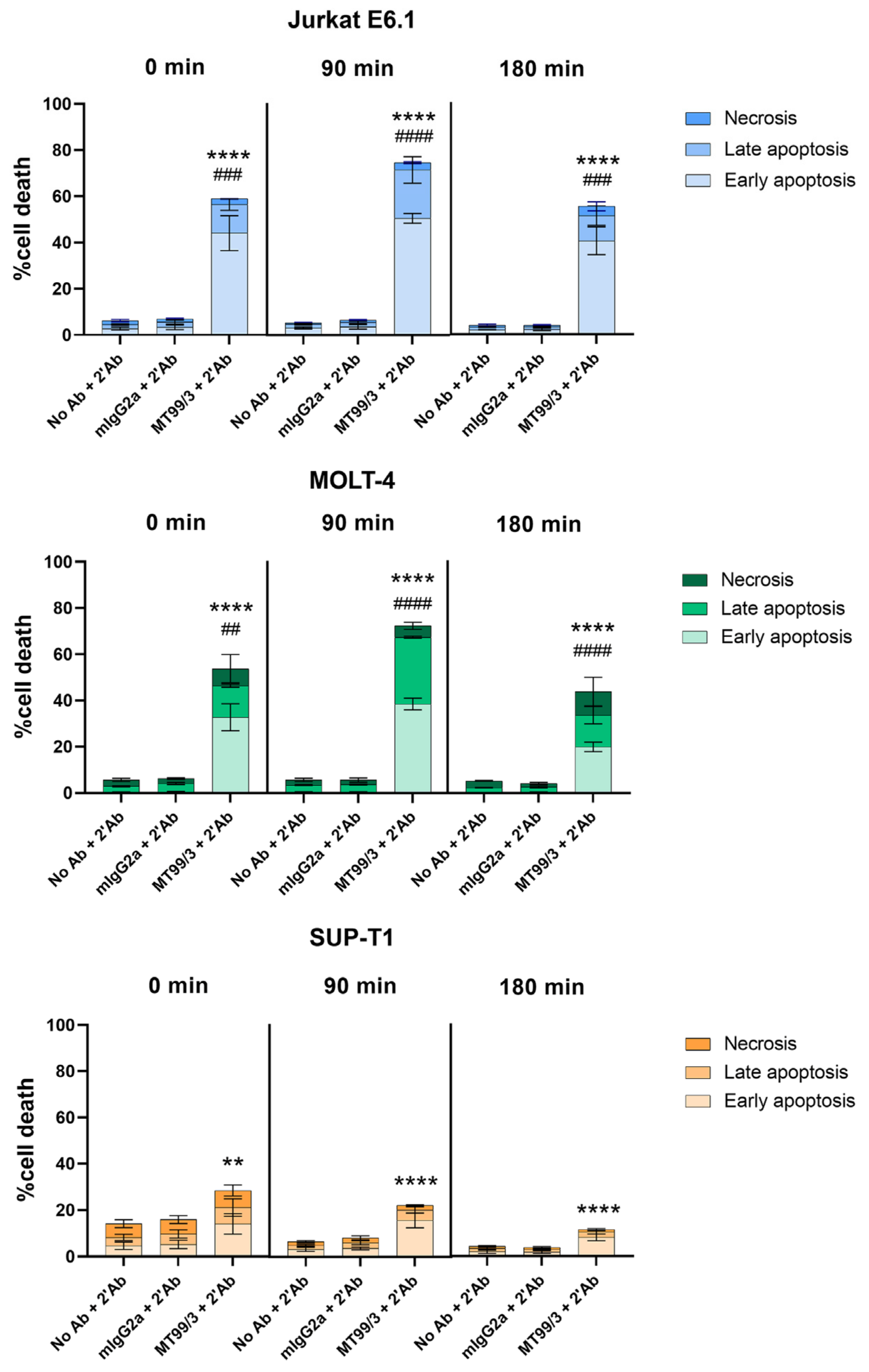
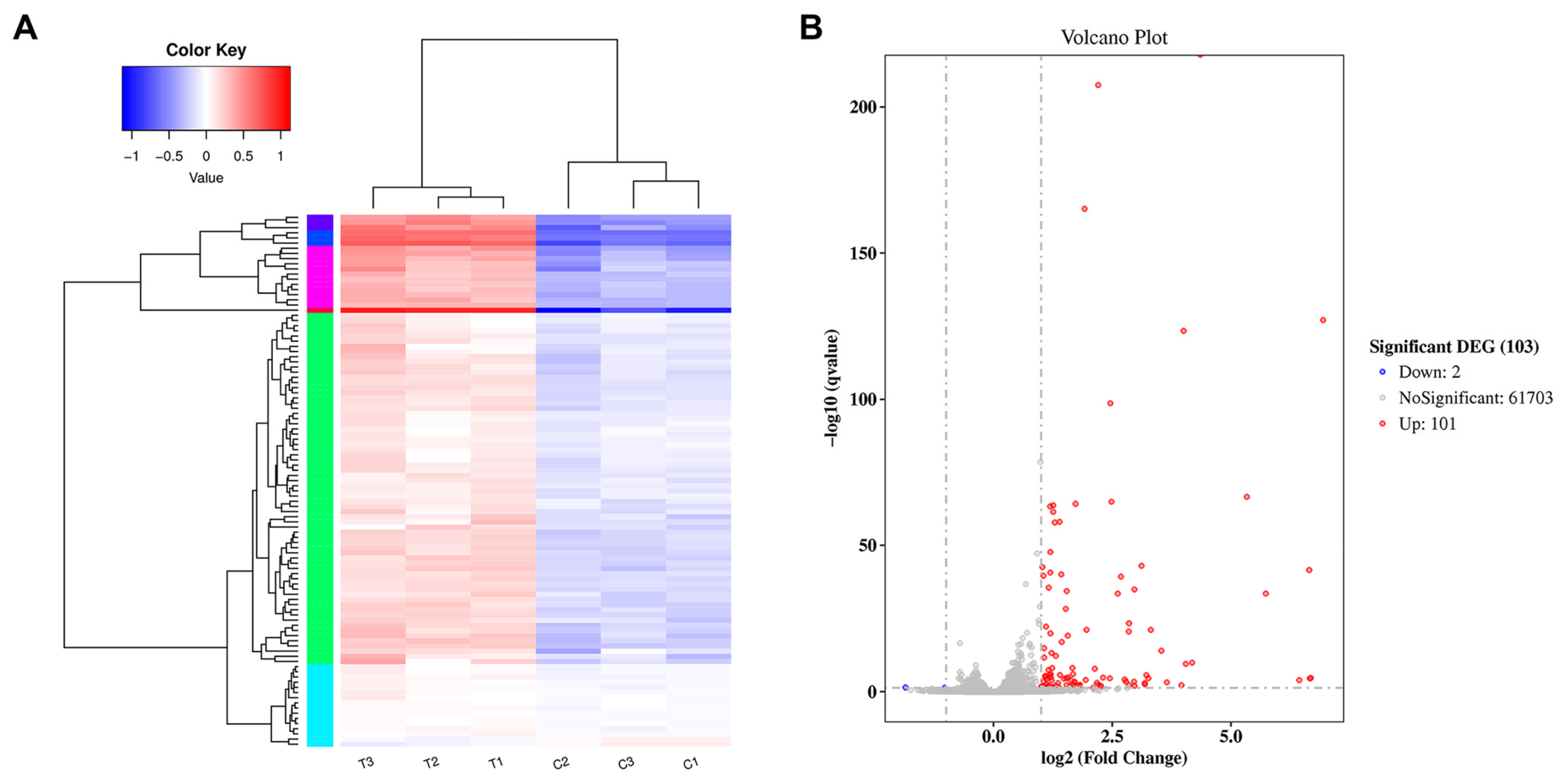
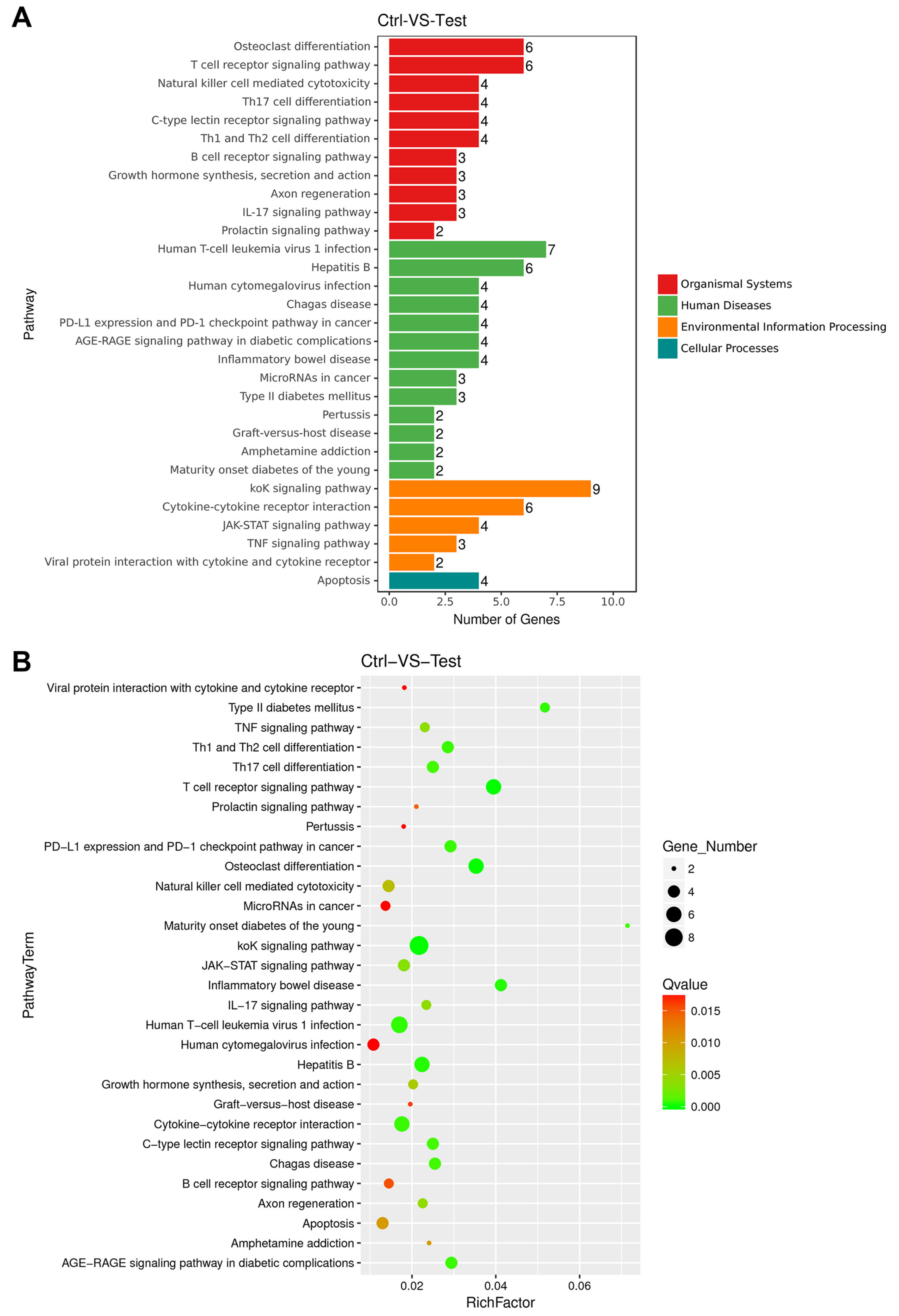
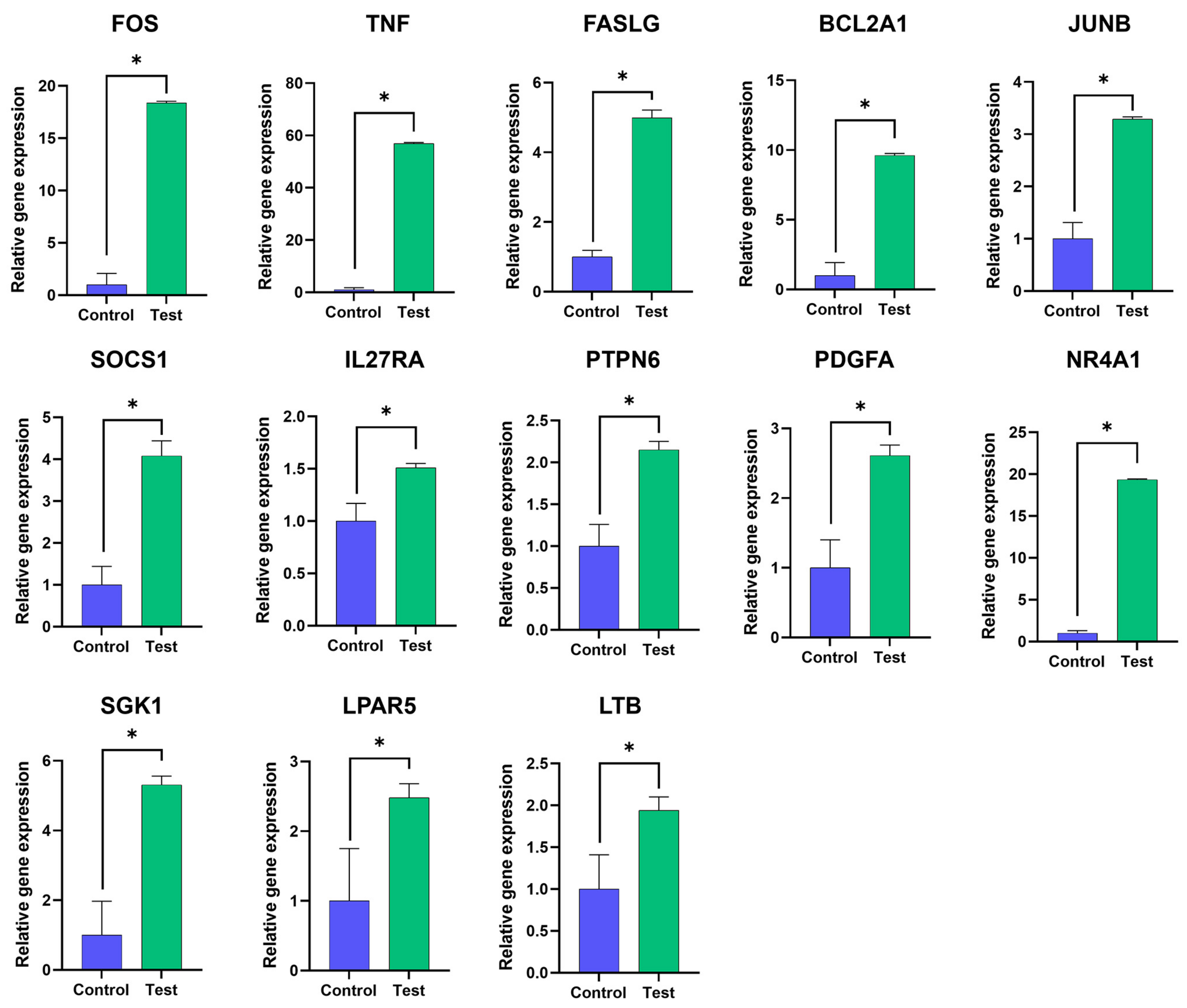
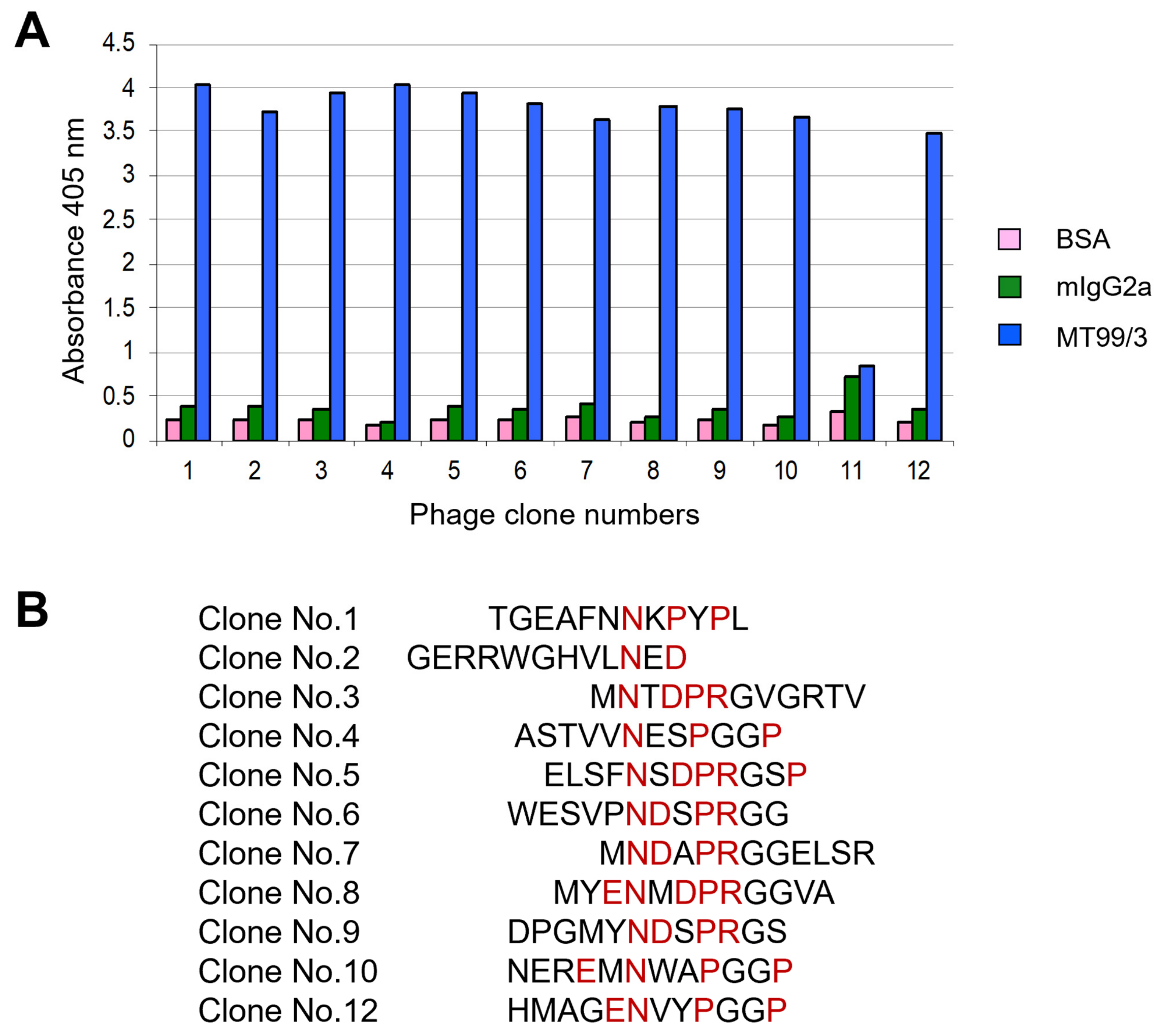

| Pathway Term | Gene ID | Description | Gene Symbol | Control FPKM ※ | mAb MT99/3 FPKM ※ | Regulated by mAb MT99/3 |
|---|---|---|---|---|---|---|
| Apoptosis | ENSG00000170345 | Fos proto-oncogene, AP-1 transcription factor subunit | FOS | 0.35 | 6.16 | Up |
| ENSG00000232810 | Tumor necrosis factor | TNF | 0.10 | 1.59 | Up | |
| ENSG00000117560 | Fas ligand | FASLG | 0.00 | 0.56 | Up | |
| ENSG00000140379 | BCL2-related protein A1 | BCL2A1 | 0.20 | 0.95 | Up | |
| TNF signaling pathway | ENSG00000171223 | JunB proto-oncogene, AP-1 transcription factor subunit | JUNB | 21.47 | 48.43 | Up |
| ENSG00000170345 | Fos proto-oncogene, AP-1 transcription factor subunit | FOS | 0.35 | 6.16 | Up | |
| ENSG00000232810 | Tumor necrosis factor | TNF | 0.10 | 1.59 | Up | |
| JAK-STAT signaling pathway | ENSG00000185338 | Suppressor of cytokine signaling 1 | SOCS1 | 1.19 | 7.21 | Up |
| ENSG00000104998 | Interleukin 27 receptor subunit alpha | IL27RA | 3.18 | 7.19 | Up | |
| ENSG00000111679 | Protein tyrosine phosphatase non-receptor type 6 | PTPN6 | 18.56 | 49.36 | Up | |
| ENSG00000197461 | Platelet-derived growth factor subunit A | PDGFA | 1.36 | 3.13 | Up | |
| PI3K-Akt signaling pathway | ENSG00000123358 | Nuclear receptor subfamily 4 group A member 1 | NR4A1 | 1.49 | 23.57 | Up |
| ENSG00000118515 | Serum/glucocorticoid-regulated kinase 1 | SGK1 | 0.72 | 2.10 | Up | |
| ENSG00000197461 | Platelet-derived growth factor subunit A | PDGFA | 1.36 | 3.13 | Up | |
| ENSG00000117560 | Fas ligand | FASLG | 0.00 | 0.56 | Up | |
| ENSG00000184574 | Lysophosphatidic acid receptor 5 | LPAR5 | 7.28 | 16.72 | Up | |
| NF-kappa B signaling pathway | ENSG00000232810 | Tumor necrosis factor | TNF | 0.10 | 1.59 | Up |
| ENSG00000227507 | Lymphotoxin beta | LTB | 2.47 | 5.18 | Up | |
| ENSG00000140379 | BCL2-related protein A1 | BCL2A1 | 0.20 | 0.95 | Up |
Disclaimer/Publisher’s Note: The statements, opinions and data contained in all publications are solely those of the individual author(s) and contributor(s) and not of MDPI and/or the editor(s). MDPI and/or the editor(s) disclaim responsibility for any injury to people or property resulting from any ideas, methods, instructions or products referred to in the content. |
© 2024 by the authors. Licensee MDPI, Basel, Switzerland. This article is an open access article distributed under the terms and conditions of the Creative Commons Attribution (CC BY) license (https://creativecommons.org/licenses/by/4.0/).
Share and Cite
Takheaw, N.; Kotemul, K.; Chaiwut, R.; Pata, S.; Laopajon, W.; Rangnoi, K.; Yamabhai, M.; Kasinrerk, W. Transcriptome Analysis Reveals the Induction of Apoptosis-Related Genes by a Monoclonal Antibody against a New Epitope of CD99 on T-Acute Lymphoblastic Leukemia. Antibodies 2024, 13, 42. https://doi.org/10.3390/antib13020042
Takheaw N, Kotemul K, Chaiwut R, Pata S, Laopajon W, Rangnoi K, Yamabhai M, Kasinrerk W. Transcriptome Analysis Reveals the Induction of Apoptosis-Related Genes by a Monoclonal Antibody against a New Epitope of CD99 on T-Acute Lymphoblastic Leukemia. Antibodies. 2024; 13(2):42. https://doi.org/10.3390/antib13020042
Chicago/Turabian StyleTakheaw, Nuchjira, Kamonporn Kotemul, Ratthakorn Chaiwut, Supansa Pata, Witida Laopajon, Kuntalee Rangnoi, Montarop Yamabhai, and Watchara Kasinrerk. 2024. "Transcriptome Analysis Reveals the Induction of Apoptosis-Related Genes by a Monoclonal Antibody against a New Epitope of CD99 on T-Acute Lymphoblastic Leukemia" Antibodies 13, no. 2: 42. https://doi.org/10.3390/antib13020042
APA StyleTakheaw, N., Kotemul, K., Chaiwut, R., Pata, S., Laopajon, W., Rangnoi, K., Yamabhai, M., & Kasinrerk, W. (2024). Transcriptome Analysis Reveals the Induction of Apoptosis-Related Genes by a Monoclonal Antibody against a New Epitope of CD99 on T-Acute Lymphoblastic Leukemia. Antibodies, 13(2), 42. https://doi.org/10.3390/antib13020042







